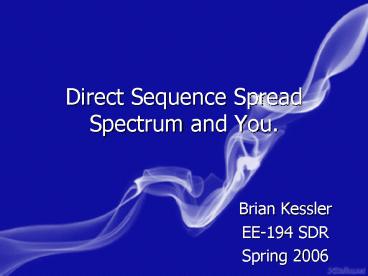Direct Sequence Spread Spectrum and You' - PowerPoint PPT Presentation
1 / 25
Title:
Direct Sequence Spread Spectrum and You'
Description:
The Real World. The real world has something that the ... Perfect World. Gaussian World. Noise - Digital. Original Data. Perfect World. Gaussian World. Noise ... – PowerPoint PPT presentation
Number of Views:808
Avg rating:5.0/5.0
Title: Direct Sequence Spread Spectrum and You'
1
Direct Sequence Spread Spectrum and You.
- Brian Kessler
- EE-194 SDR
- Spring 2006
2
Spread Spectrum
- Spread Spectrum is a modulation technique that
takes a signal centered around one frequency and
spreads it out over others. - This is designed to lower the effects of noise,
make it difficult to jam, and/or make it
difficult to intercept. - Spread spectrum techniques use pseudo noise to
transmit the signal, making the received signal
sound like noise or momentary flares to the
untrained receiver.
3
Spread Spectrum
F
F
Normal Signal
Signal with Spread Spectrum
4
Spread Spectrum
- For a spread spectrum transmitter-receiver system
to work, both points need the ability to generate
identical pseudo noise signals - Besides Direct Sequence Spread Spectrum (DSSS),
the other popular technique is Frequency Hopping
Spread Spectrum (FHSS). - This modulation does exactly what the name
implies, hopping from carrier to carrier in a
pseudo random order.
5
DSSSDirect Sequence Spread Spectrum
- Each data bit is combined with a n-bit spreading
code - Logically the combination is an XOR, but using
Bipolar notation instead of Unipolar designations
for the bits, the system can be modeled with only
a multiplier. - This means instead of a 0 and 1 data signal, -1
and 1 are used
6
DSSS
A B C
0 is high
C A XOR B
7
DSSS Transmission (Theoretical)
- The Data signal is generated and enters a
spreader - Inside the spreader, a pseudo noise signal is
generated, and then XORed with the data signal - D(t) XOR N(t) Sd(t)
- The new signal is then modulated with an analog
technique such as BPSK
8
DSSS Transmitter
Spreader
Sd(t)
Modulator BPSK
S(t)
Digital Data d(t)
N(t)
PN Source
9
DSSS Reception (Theoretical)
- Once the data is received, it is again
demodulated and then sent into a
de-spreader to produce the original signal. - Sd(t) XOR N(t)
- D(t) XOR N(t) XOR N(t)
- D(t)
10
DSSS Receiver
Digital Data d(t)
De-spreader
Sd(t)
S(t)
Demodulator BPSK
C1(t)
PN Source
11
Modeling DSSS
- Working in the binary (0,1) domain turned out to
be quite complicated, with simulinks data type
compatibility issues. - By using the Unipolar to Bipolar Converter
block on both the data signal and pseudo noise
signal, then multiplying and converting back,
binary XOR was simulated. - -1 X -11
- -1 X 1-1
- 1 X -1-1
- 1 X 1 1
- Note in this case, 0 is high.
12
Spreader
13
Modeling DSSS
- The Signal was then modulated using the BPSK
block to complete the Transmission Block
14
Receiver
- On the other end, the reverse was done.
- The received signal was demodulated and sent into
the de-spreader
15
De-spreader
- The De-spreader works just like the opposite of
the spreader - The original data was then sent out of the
de-spreader
16
The Real World
- The real world has something that the simulated
world doesnt NOISE - To Test its efficiency, the signal was
transmitted along a path with White Gaussian Noise
17
Noise - Analog
Perfect World Gaussian World
18
Noise - Digital
Original Data Perfect World Gaussian
World
19
Noise
- With the Signal to Noise Ratio set to 10dB, the
Noise was wreaking havoc on the signal. - The system was doing well to compensate, but
still was having a 7 error rate. - More correction was needed at the receiver end.
20
Integration
- By integrating the received signal over the 10
samples data signal, an averaging system was
created. - Outputted would be a number higher than 0 if the
signal was more 1 than 0, and vice versa. - Then, after being sent through a trigger, the
signal would be restored to its 1,-1 form
21
New Receiver
22
New Receiver
- This method would produce an bit error rate (BER)
at a 10dB SNR of .09 - For a digital sound signal, this is more than
acceptable - For wifi, which is a major application of this
modulation technique, this is acceptable too, due
to the built in error correction techniques which
are capable of fixing more than 1 bit errors.
23
Final Form
24
Questions?
?
?
?
?
?
?
?
?
- ?
?
?
?
?
?
?
?
?
?
?
?
?
?
?
?
?
?
?
?
?
?
?
?
?
?
?
?
?
?
?
?
?
?
?
?
?
?
?
?
?
?
25
Work Cited
- http//www.sss-mag.com/ss.html
- http//www.bee.net/mhendry/vrml/library/cdma/Chapt
er1.htm - http//en.wikipedia.org/wiki/Direct-sequence_sprea
d_spectrum - www.raylink.com/whitepaper/fhss_dsss.pdf

